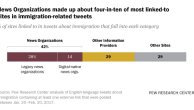The definition of news on the three evening newscasts has been transformed, from a diet that was more than a third lifestyle, celebrity and crime to something that has shifted back to levels of traditional hard news we have not seen in decades.
In June, lifestyle and feature stories made up 20% of the nightly newscasts. By late October, they had dropped to just one percent. Celebrity news, which made up a full 5% of the nightly news time in June, had vanished completely.
Crime news, traditionally a staple of local news, had been growing on network news as well in recent years, despite a significant drop in crime nationally. Now it has dropped on the networks, too. In June, crime made up 12% of the nightly news stories. By October it had fallen to 3%.
|
||||||||||||||||||||||||||||||
In its place there has been a return to the subjects that once made up the traditional definition of hard news on the networks—domestic affairs, government, military and international relations. These subjects, which made up less than half the time on nightly news in June (46%), by October made up 80%.
The rest, business and science news, decreased somewhat after September 11, from 18% to 16% of stories.
Are the low numbers for traditional hard news seen this June just a case of the summer doldrums? The evidence suggests not.
|
||||||||||||||||||||||||||||||||||||
Earlier research by the Project, which examined the subject of news in various media outlets over a 20-year span, found that what the network nightly newscasts covered this summer was typical of their news agenda in recent years.1
That earlier study found that traditional hard news made up less than half of what appeared on the nightly news by 1997, down from roughly 60% in 1987 and roughly 70% in 1977.
In effect, the networks have returned, at least for the moment, to a general menu of news that is closer to what we saw in the 1970s than anything seen in roughly a quarter century.
Some differences between the three networks, before and after September 11, are noticeable in the data.
The CBS Evening News with Dan Rather did the most traditional hard news before (53% during the period studied in June, compared with 44% for ABC and 39% for NBC). And CBS is doing the most hard news now (a striking 86%, compared with 76% for ABC, 79% for NBC).
The other differences between the networks are smaller.
ABC’s World News Tonight with Peter Jennings did the fewest stories on business and the economy in June (10%) and the most now (7%). Its competitors both did more on business in June (17% CBS and 16% NBC), and both dropped to doing hardly any in October (just two stories each during the two weeks studied).
NBC did slightly more science and technology stories in the 10 days studied in October (14), all of them about anthrax and bio-terrorism.
Footnotes
1. See “Changing Definitions of News: A Look at the Mainstream Press Over 20 Years,” Project for Excellence in Journalism, March 6, 1998.




